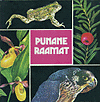 |
 |
|||
|
It may sound unusual, but the real red data book is not necessarily bound as a book. It is the information meant for specialists on nature conservation for accomplishing their tasks. Print numbers and colorful illustrations are not thus most important features of the red data books. It is absolutely necessary, though, to update frequently the relevant information on the conservation status of endangered species - and this is what is done at regular basis by conservation specialists. The Nature Conservation Committee of Estonian Academy of Sciences has initiated the compilation of Red Data Book in 1979, 1988 and 1998. The current web version of the Red Data Book is based on 1998 edition of the Red Data Book. In the end of 2008 the new Estonian Red List of Threatened Species was compiled according to the rules of IUCN. The new database is available on eBiodiversity website. We can safeguard the life-supporting systems of our nature only by preserving its diversity. The best we can do is to make a complete inventory of all life forms and investigate the factors of threat to the endangered species. The Red Data Book has currently a certain role in this process. This is one way to act in order to safeguard the future of endangered species. |


